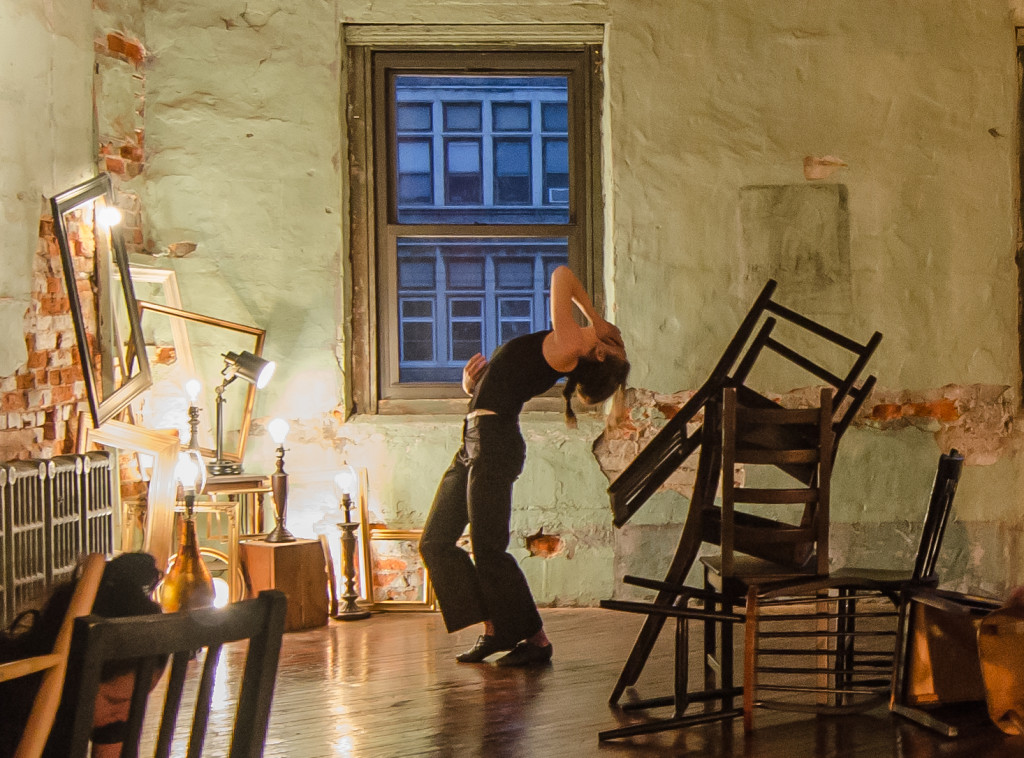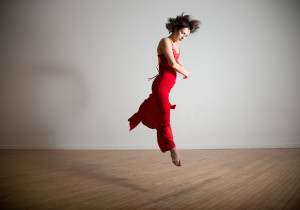Presented as part of the curated Fringe (Live Arts Festival) in 2010, choreographer Olive Prince is producing one of the premiere dance events of this year’s Fringe Festival. Her OF OUR REMNANTS “is an intimate site-specific work where visual art and dance collide”. Dancers interact with a collection of chairs, empty frames, and “abandoned objects” in an engrossing and expressive hourlong performance which saw a brief run earlier this year. Olive talks to Phindie about the literary inspiration behind the show and her collaboration with a visual artist and dancers. [The Iron Factory, 118 Fontain Street, 3rd Floor] September 9-12, 2015; fringearts.com/of-our-remnants.

Phindie: Are you a hoarder?
Olive Prince: If I keep all the objects we’ve collected for this piece people might begin to wonder…. but no not in life only for the sake of making art.
Phindie: What inspired OF OUR REMNANTS?
OP: Many years ago I read the book Love in the Time of Cholera by Gabriel Garcia Marquez. I had folded down a page of an image that inspired me. It described a house that was under the rule of death. “Every object of value had been locked away with care for safekeeping, and on the bare walls there were only the outlines of the pictures that had been taken down. Chairs from the house, and those lent by neighbors, were lined up against the walls … and the empty spaces seemed immense and the voices had a ghostly resonance because the large pieces of furniture had been moved to one side…”
For years I imagined what I could do with this image. Like a painting, I wanted to recreate it in a space and make a dance from it. I didn’t know what it was about for me personally or what would transpire in the piece. I simply wanted to see what I could do with this image.
Phindie: What moved you to finally use it?
OP: Five years later, I got a residency at the Iron Factory. I walked into the space and thought this is the place for Gabriel Garcia Marquez’s poetic words.
I was simultaneously doing research into the Tao Te Ching. Six months after delivering my baby I made a solo based on one off the teachings that says “True perfection seems imperfect, yet it is perfectly itself. True fullness seems empty, yet it is fully present. True straightness seems crooked. True wisdom seems foolish. True art seems artless.” It touched something deeply in me about my life and transitioning into parenthood.
The movement material I developed for the solo became the research seeds for the piece. Together these two elements inspired OF OUR REMNANTS.

Phindie: How was it developed after the genesis?
OP: I asked my good friend, Carrie Powell, who is a visual artist, writer, creative arts therapist, and mother if she wanted to collaborate and help me re-create the visual image from Love in the Time of Cholera. I also enlisted design artist Kaitlin Chow who was once my student at Drexel University to help collect objects and create an installation in the space where the dance and the audience would exist.
I worked with my dancers to develop movement that originated from the words in the text, developed ways the body could move in lines and circles, as well as structures to explore falling bodies in the space, the concept of emptiness, and the idea of two people connecting. I was also interested in breaking apart movement patterns so as we developed movement we would “shuffle” the order to challenge ourselves in movement generation.
Phindie: What was Carrie Powell’s role as a visual artist?
OP: Carrie became integral in how the ideas in the piece started to form into a cohesive direction. She would come to rehearsal and write poetry or draw based on what she was seeing. She gave them to me and I would then use it to develop more movement material or an idea for a character in the piece. It was a constant process of reflection and response in both of our art forms. We coined the process “in-the round reciprocity” and I look forward to trying it again to develop another work.
Phindie: What impresses you about the dancers in the piece? What do you look for in a dancer?
OP: These dancers kick ass! They bring exquisite technique combined with a fearlessness to be challenged as performers (the walls literally crumbled during the making process and the audience is literally three inches from us during some sections!) They have joined into this work as full thinking, moving beings that participate in making movement material and choices within the structure of the piece.
Phindie: What do you look for in a dancer?
OP: I am not interested in dancers all looking the same. I am interested in pulling out what is honest and real for each person and trying to find ways they can “live” on stage with room for subtle differences in each performance based on what’s happening in that moment. I have found that when we can access an emotional state within defined physical parameters there are endless options for the performer to transcend into a different state. You have to ride the present moment, the physicality of the work, and the emotional trance of the work. It demands that the dancers be gutsy and honest to meet the challenges at hand. I am asking the dancers to not only be technically on point, but also energetically real with the moment, the space, and one another.
Phindie: What has changed since your run in May?
OP: In preparing for this show, we have shuffled parts around and gone further into investigating certain sections of the work. Carrie Powell changed the visual installation quite dramatically. She has adapted a monochromatic approach to the frames, lamps, and objects and painted them all to match the walls. We are looking at the space as the ultimate body and vessel. How the audience enters the space will be finessed differently as well to allow the audience to enter the space at different times. The piece opens with the audience wandering through the space as a stationary solo and duet seep into the ambient environment.
About a month before our run in May I broke my foot, which took me out of the piece. I was fortunate I had an understudy in the mix and brought in another dancer. I put myself in the work as a character that watched the entire thing from a chair in the corner. It became a powerful metaphor that I would not have thought of without the limitation in my own body. I’m working to allow this character to emerge differently now that I have full mobility back.
Phindie: What is the meaning behind the objects on stage?
OP: The objects are an abstraction of the image and time period from Love in the Time of Cholera. We choose empty frames, lamps, chairs, teacups, and a painting by Carrie Powell to construct a space that is intimate and has character. These objects also housed or contained our loved ones. They become the remnants that are the connective tissue of what was lost, the metaphor for what is left, the people left to live, the ghosts of people who have passed, and the objects we hold onto. OF OUR REMNANTS is a moving metaphor exploring: union and death, together and apart, collective and alone. The objects are representative of the remnants that are collective in the body, the space, and amongst one another eventually distill to union.
Phindie: “What will survive of us is love.” Discuss.
OP: I love this poem! It’s ephemeral. It reminds me of a dance. We do it, we exist in it, we are “it” and then it is gone and the only thing left is the feeling, the memory, and the imprint of what was. It shaped us in the doing. Us is fleeting because it is a union that is not always constant. Seasons weather the sculpture of us and erode us into different forms. And the repercussions of love remains…
Phindie: What other dance (or other) shows are you looking forward to this Fringe?
OP: I’m excited to see After Rehearsal/Persona, and Lucinda Child’s Available Light. All are happening at the Drexel University Armory and I can’t wait to see how each piece takes place in that fantastic, massive space.
